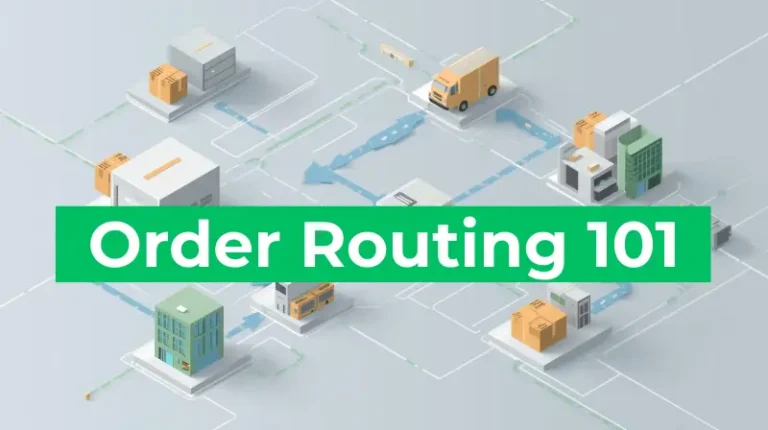Your Seller Fulfilled Prime (SFP) Eligibility Depends On Your Carrier’s OTD Performance

Last updated on August 21, 2025

In this article
 12 minutes
12 minutes
- Introduction to Amazon Seller Fulfilled Prime
- Enrollment and Eligibility
- What Changed in Amazon SFP
- The Carrier OTD Problem
- Why Sellers Can’t Just “Pick a Better Carrier”
- The Imbalance of Risk in SFP
- Merchant Fulfilled Network: The Backbone of SFP
- Strategies to Survive Carrier OTD Dependence
- Bigger Picture: Why This Matters Beyond Amazon
- Final Thoughts: The OTD Sword Hanging Over Sellers
- Frequently Asked Questions
Amazon has a cruel irony baked into Seller Fulfilled Prime (SFP). You can follow every rule, hit every ship-by deadline, and still lose your Prime badge. Why? Because SFP doesn’t ultimately measure you, it measures whether your carrier delivered on time. And if they don’t, you pay the price.
Amazon fulfillment includes both Fulfillment by Amazon (FBA) and Seller Fulfilled Prime (SFP), with SFP serving as an alternative to using Amazon’s fulfillment centers for order processing and shipping.
To understand how Seller Fulfilled Prime works, it’s important to know that Amazon sellers can choose between FBA and SFP, and third-party Amazon sellers play a key role in both programs. In SFP, sellers ship Prime orders directly from their own warehouse, provided they meet Amazon’s strict criteria for fast and reliable delivery.
Unlike Fulfillment by Amazon (FBA), where Amazon handles the entire fulfillment process, FBA sellers send inventory to Amazon’s fulfillment centers, where Amazon manages storage, picking, packing, and shipping. In SFP, the seller manages the fulfillment process themselves. This means that your performance metrics are directly tied to how well you and your chosen carrier execute each step.
Slash Your Fulfillment Costs by Up to 30%
Cut shipping expenses by 30% and boost profit with Cahoot's AI-optimized fulfillment services and modern tech —no overheads and no humans required!
I'm Interested in Saving Time and MoneyIntroduction to Amazon Seller Fulfilled Prime
Amazon Seller Fulfilled Prime (SFP) empowers third-party sellers to offer Prime shipping benefits directly from their own warehouses, without relying on Amazon’s fulfillment centers. By joining the seller fulfilled prime program, sellers can display the coveted Prime badge on their listings, signaling fast and free shipping to millions of Prime customers. This not only boosts visibility but also helps sellers gain access to Amazon’s loyal customer base and expand their sales channels.
To qualify for Amazon Seller Fulfilled Prime, sellers must meet strict criteria that reflect Prime customers’ expectations, such as rapid shipping, high order accuracy, and exceptional customer satisfaction. SFP sellers are responsible for managing their own fulfillment process, including inventory management and shipping, to ensure every Prime order meets Amazon’s high standards. Sellers who successfully complete the SFP trial period and maintain Prime status can enjoy increased sales, improved customer trust, and a stronger presence in the competitive Amazon marketplace. For many online businesses, Seller Fulfilled Prime offers a unique opportunity to control their fulfillment process while reaping the benefits of the Prime program.
Enrollment and Eligibility
Enrolling in the Seller Fulfilled Prime program requires careful preparation and a commitment to meeting Amazon’s demanding standards. To get started, sellers must have a professional selling account and a default shipping address within the United States. Once these prerequisites are met, sellers can configure their shipping settings in Seller Central to enable Prime shipping and ensure their offers reflect Prime customers’ expectations for speed and reliability.
During the SFP Trial Period, sellers must demonstrate their ability to consistently meet Amazon’s minimum performance requirements, including on-time delivery, valid tracking, and fast shipping speeds. Maintaining a high level of customer service and meeting Prime requirements is essential for keeping Prime status and avoiding removal from the program. Sellers should regularly review their shipping settings and monitor performance metrics to ensure they continue to meet the standards of the Seller Fulfilled Prime Program. By understanding and preparing for these requirements, sellers can position themselves for success and provide an outstanding experience to Prime customers.
What Changed in Amazon SFP
Amazon recently tightened the screws on SFP with updated rules:
- 93.5% weekly On-Time Delivery Rate (OTD) across all SFP orders
- 100 minimum shipments per month to even qualify
- Strict one- and two-day delivery promises across 48 states
- Minimum Product Detail Page Views by product size tier
- ≤ 0.5% Pre-fulfillment Cancellation Rate tracking Seller-cancelled orders
These rules represent the minimum performance requirements that sellers must meet and maintain to qualify for and retain the Prime badge. Maintaining prime status once eligibility is achieved is essential to ensuring you keep the Prime badge and all the associated benefits for your Prime listings.
If you fall short, even by a sliver, your Prime badge disappears until you claw back up. If you do not meet the requirements, the Prime badge displayed on your Prime listings and Prime items will be removed, significantly impacting your product visibility and sales. It’s no longer about doing “most” things right. It’s about perfection. But here’s the twist: perfection isn’t even in your hands.
The Carrier OTD Problem
Carriers control the final leg of delivery, and Amazon grades you on their performance. SFP sellers must ensure fast shipping speed and nationwide delivery coverage to meet Amazon’s requirements, which adds significant logistical complexity. You can hand off a package on time, scan it into the network, and still get burned if the carrier misses its truck cutoff, misroutes at a sortation center, or has a weather delay.
For sellers, this feels rigged. You’re being measured on someone else’s reliability. And unlike FBA, where Amazon absorbs the risk, (and doesn’t ding itself for late deliveries), SFP makes your business hostage to the carrier’s OTD. Many sellers use Amazon Buy Shipping services to purchase shipping labels, manage shipments, and track deliveries through Amazon’s approved carrier network, but you are still responsible for the final delivery metrics.
Imagine running 1,000 SFP shipments in a month. You hit 100% On-time Shipment. But UPS or FedEx delivers 60 late. That’s a 93.9% OTD, barely scraping the requirement. If they miss 70? You’re at 93.0%. Badge gone. Sales crater.
Looking for a New 3PL? Start with this Free RFP Template
Cut weeks off your selection process. Avoid pitfalls. Get the only 3PL RFP checklist built for ecommerce brands, absolutely free.
Get My Free 3PL RFPWhy Sellers Can’t Just “Pick a Better Carrier”
Some might say: use better carriers. But Amazon’s OTD system doesn’t care about nuance. Even the best carriers have bad weeks. Peak season surges, labor strikes, and regional weather, these events sink OTD performance fast.
Carriers are incentivized to protect their own high-volume clients, not your handful of SFP parcels. And regional carriers often can’t cover Amazon’s two-day footprint. To participate in SFP, you must assign your SKUs to a prime shipping template within Seller Central, which enables your products for Prime shipping. That leaves you with UPS, FedEx, or USPS, and each has blind spots Amazon Shipping is rolling out as a 4th option in many regions, but it has its own limitations.
A flexible prime strategy is essential to adapt to carrier performance and ongoing delivery challenges.
The Imbalance of Risk in SFP
Amazon frames SFP as freedom: control your inventory, keep FBA fees at bay, win the Buy Box. SFP also allows sellers to manage their own storage space, potentially reducing overhead costs compared to FBA. But the risk transfer is brutal. You carry the cost of fast shipping and the accountability for late deliveries you didn’t cause. These fast shipping costs can significantly impact your profit margins, making it vital to carefully calculate all expenses to ensure your business remains profitable.
This is why SFP feels unsustainable for many sellers. You’re punished for variables beyond your control, while Amazon shields itself from customer disappointment by pointing to you.
Merchant Fulfilled Network: The Backbone of SFP
The Merchant Fulfilled Network (MFN) serves as the foundation of the Seller Fulfilled Prime program, allowing sellers to fulfill Prime orders directly from their own warehouse while maintaining control over the entire fulfillment process. Through MFN, sellers can leverage Amazon’s shipping services, such as Amazon Buy Shipping, to purchase shipping labels, track shipments, and ensure fast and free shipping for Prime customers. Sellers who want to fulfill orders from channels other than Amazon can consider Amazon Multi-Channel Fulfillment (MCF), which allows the use of Amazon logistics across diverse ecommerce platforms.
Participating in the merchant fulfilled network requires robust inventory management, reliable fulfillment capacity, and a commitment to meeting Amazon’s strict performance standards. Sellers must carefully manage shipping costs, maintain inventory visibility, and ensure their fulfillment process can handle the demands of Prime orders. By optimizing their fulfillment operations and leveraging the flexibility of MFN, sellers can expand their online business, fulfill orders efficiently, and maintain a competitive edge in the Prime program. However, success in SFP depends on the ability to balance fulfillment costs, meet customer expectations, and consistently deliver a Prime-worthy experience.
Strategies to Survive Carrier OTD Dependence
So how do you navigate this trap? There are a few imperfect strategies. First, evaluate different fulfillment options, such as SFP, FBA, and third-party logistics providers, to determine which best optimizes your delivery performance and meets Amazon’s requirements. Having a clear prime strategy is essential for optimizing your participation in Seller Fulfilled Prime, as it allows for continuous adjustments to meet Amazon’s evolving standards.
- Spread Volume Across Carriers: Don’t let a single carrier’s bad week wipe out your badge. Split shipments where it makes sense.
- Build Weekly Monitoring, Not Monthly: Amazon now enforces OTD weekly. Track performance in real-time, not at the end of the month.
- Negotiate Carrier SLAs (Good Luck): Some enterprise-level sellers can hold carriers to OTD service guarantees. But for most, leverage is thin.
- Use Third-Party Tools and Networks: Automated routing, peer-to-peer fulfillment, or SFP-optimized 3PLs can spread risk across regions and carriers. Selecting a reliable fulfillment partner is crucial to consistently meet Amazon’s strict delivery standards and maintain Prime eligibility.
- Maintain FBA as a Safety Valve: For high-stakes SKUs, keep backup inventory in FBA. Effective inventory management is essential when balancing stock between FBA and SFP to ensure Prime eligibility and avoid stockouts. Planning for seasonal demand is also critical to ensure product availability during peak periods and to optimize storage and shipping costs. Losing Prime visibility can crush sales overnight.
Participating in Seller Fulfilled Prime allows you to create seller fulfilled prime offers, giving you the advantage of maintaining the Prime Badge and offering fast, free shipping while managing your own fulfillment. As an SFP seller, you are responsible for meeting strict performance requirements, but you also gain greater control over your fulfillment process and can benefit from increased competitiveness in the marketplace.
Scale Faster with the World’s First Peer-to-Peer Fulfillment Network
Tap into a nationwide network of high-performance partner warehouses — expand capacity, cut shipping costs, and reach customers 1–2 days faster.
Explore Fulfillment NetworkBigger Picture: Why This Matters Beyond Amazon
This isn’t just about SFP. It’s a warning shot for ecommerce operators everywhere. As marketplaces push more accountability onto sellers, the margin for error shrinks. These challenges are highly relevant for anyone running an online business, especially third-party Amazon sellers, as fulfillment and logistics are critical to supporting growth and customer satisfaction.
The lesson: logistics performance is becoming a brand asset. Customers don’t see UPS or FedEx on the box. They see you. And if their package is late, they’ll blame you, not the carrier, not Amazon. Effectively managing customer service inquiries is also essential to maintain customer satisfaction and control over the sales process.
In other words: the weakest link in your supply chain isn’t optional. It’s existential. The competitive landscape for ecommerce is becoming more challenging as marketplaces continue to raise performance expectations.
Final Thoughts: The OTD Sword Hanging Over Sellers
Amazon has built SFP into an almost impossible standard. Sellers who want the Prime badge must first complete a Prime trial period, a 30-day window where they must meet strict Prime performance and shipping requirements to qualify for SFP. Even after qualifying, maintaining prime status is an ongoing challenge, as sellers must consistently adhere to Amazon’s high standards and performance metrics to retain the Prime badge. That’s not partnership, it’s risk transfer disguised as opportunity.
So the real question for sellers isn’t: can you hit the SFP metrics? It’s: can your carrier? And if not, what’s your Plan B when Amazon yanks your badge?
Frequently Asked Questions
What is the On-Time Delivery Rate (OTD) for SFP?
Amazon requires a 93.5% weekly OTD for all SFP shipments. Sellers must also maintain a low cancellation rate, specifically less than 0.5%, as high cancellation rates can jeopardize their Prime badge. This means carriers must successfully deliver nearly every package on time for sellers to keep their Prime badge.
How does Amazon calculate OTD for SFP?
Amazon tracks the promised delivery date vs. the carrier’s actual delivery scan. Even if you ship on time, the score reflects the carrier’s performance, not yours.
Can weather or carrier errors still hurt my SFP metrics?
Yes. Amazon doesn’t adjust for weather delays, misrouted packages, or carrier staffing shortages. Sellers are penalized for factors outside their control. Though more recently, Amazon announced that it, in its sole discretion, would exempt late deliveries due to weather conditions where they can verify that weather impacted carrier networks in a region. No Support Ticket necessary. But we’ve yet to see this in practice.
What happens if I miss the SFP OTD requirement?
If your OTD falls below the threshold, Amazon suspends your Prime badge. This usually results in an immediate drop in Buy Box wins and sales volume. Sellers must start over in the SFP Trial if they wish to re-attempt eligibility.
How can sellers protect themselves from OTD failures?
Options include diversifying carriers, tracking OTD performance weekly, using 3PLs with multi-carrier capacity, and keeping FBA inventory as a fallback for critical products.
Sellers should regularly monitor their performance metrics and manage SFP settings within Seller Central. Amazon Seller Central provides the most up-to-date information on SFP requirements and performance. To ensure you meet Prime delivery promises, configure shipping settings in Seller Central according to Amazon’s guidelines. Regularly reviewing and updating your shipping settings is essential to maintain Prime eligibility and optimize delivery performance.

Turn Returns Into New Revenue





